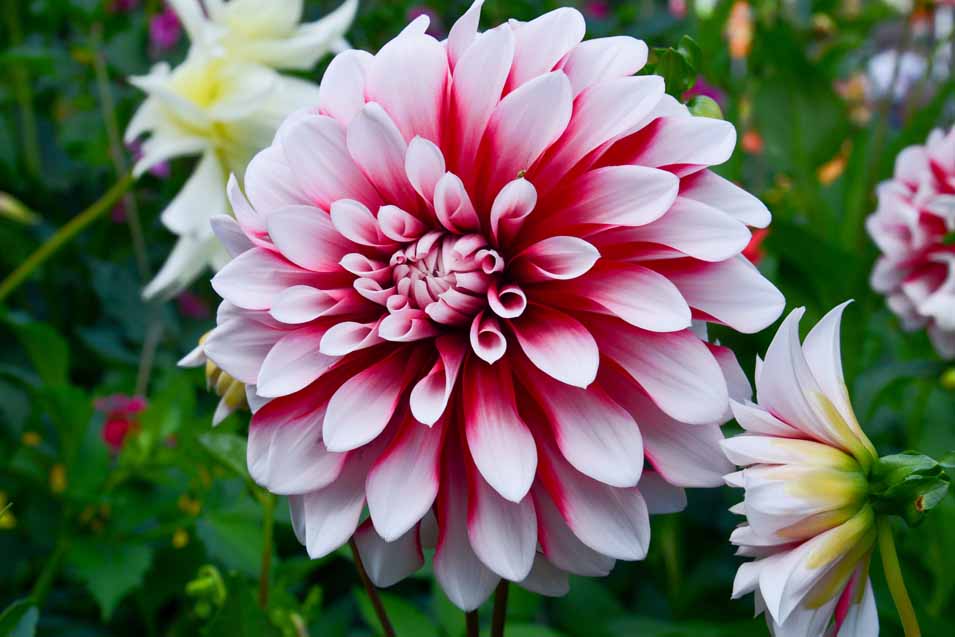
Dahlias are definitely the “cream of crop” when it comes to flower gardening. In fact, they have earned the nickname “flower of flowers”. The blooms are so ornamental that they almost look like they are fake flowers. A fully-blossomed dahlia appears to be a piece of art, and artists frequently use their picturesque attribute to add a touch of class to their paintings, sculptures and photographs. Beside their exquisiteness, dahlias have an interesting history, original traits and an abundance of variety. Some gardeners say they are easy to grow, but others claim that cultivating dahlias is quite a task.
History of the Dahlia
The history of dahlias can be tracked back to the mid-1600s when Spanish explorers made drawings of the flowers found in Mexico. They were grown and used by Aztec Indians for medical remedies during the Spanish expedition. In the 1700s, parts of the plant were sent from Mexico to a botanist in a garden in Madrid, Spain. The botanist used the plant parts to cultivate new flowering plants. He named the genus after a reputable Swedish botanist, Andreas Dahl. Since then, the native of Mexico has gained popularity throughout the world and they are a favorite for flower gardens in the United States and Europe. The dahlia is the national flower of Mexico.
Traits of the Flowering Plant
Dahlias are perennial plants, so they will continue to bloom for more than two years, but usually have a longer lifespan. They bloom in the spring and continue to bloom through autumn, until the frost comes. They are a great addition to flower gardens if you like long-blooming flowers. Depending on the species, dahlia plants range from one foot high to six feet tall. The diameter of the flowers is as little as two inches to the big flowers that are twelve inches in diameter.
Dahlias can be started from seeds, as transplants, or grown from the roots. Growing them from transplants or roots is better than growing from seeds because they are hybrids, which means they are grown from a cross-breed of more than one type of plant. They have a tuberous root which means that the root spores into the ground and over time new spores sprout creating new flowers.
Amazing Variety
There is an astonishing variety of dahlias. They are cultivated as hybrids, so the assortment of flowers as far as diameter, height and color depend on the curiosity of the breeders. There are lots of species grown from the genus of the dahlia.
There are species of dahlias that produce flowers that are tiny as well as species that produce enormous blooms. The forms of the flowers are countless ranging from pom-poms to peony forms. All dahlias are original and they can’t really be compared to other flowers. Some are daisy-like, some are similar to orchids, and some are like cactus flowers, but really, they are so unique that they can’t be compared. The variety of dahlias is colorful and usually bright, although there are some bronze-tones. The flowers are available in single colors, bi-colored or variegated.
Planting and Care of Dahlias
Planting dahlias is easy; however, they a have a few requirements to be considered when choosing where and when to plant them. Dahlias are sensitive to frost, they require sun, and they have no tolerance for water-logging soil and high winds. When choosing a place to plant them, make sure that the area is not subject to winds and that the area is in the sunlight at least six hours a day. Plant them after the last frost and prepare your soil by composting organic matter to make sure that it is well-draining. If you accommodate these few prerequisites, you can assure that you have the right environment for growing dahlias.
The spacing of the plants depends on the species. If you have the bedding type, they should be planted nine to twelve inches apart. The ones with small flowers, that are bedding plants, should have two feet between them. The large-flowering plants are best spaced three to four feet apart. They will also require support since will be tall, so placing stakes or trellises to tie them do as they grow is a good idea. The tubers should be buried about six inches deep. Making an eight inch hole and refilling it to six inches will allow the root room to grow.
Throughout the growing season, you will need to water the dahlias at least once a week or more often if it is hot. The soil should be kept moist. To increase the size of your flowers, pinching off the side buds will help.
At the end of the autumn, you will need to cut back the plants if you intend to leave them in the ground during the winter. If you have bad winters, you may choose to lift your roots and store them inside. To keep them from dying, they need to be stored in a place that is not less than 35 degrees and not more than 50 degrees and they occasionally need to be sprinkled will water to keep them from drying out. The roots can be replanted in spring.





































